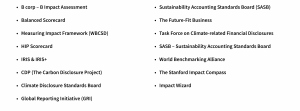Meaningful Business (MB:) What are the biggest challenges right now in accurate measurement and reporting of impact?
Darshita Gillies (DG:) Words such as ‘impact’ are becoming overused. There is a lot of noise. This is getting in the way of the substance behind impact; and of a shared societal understanding of what ‘impact’ really means. Many organisations use this word without actually measuring or tracking. Without measuring outcomes there won’t be evidence of success – or results to learn from. Tracking impact is key, as these issues are often complex and change requires patient capital. Tracking enables an understanding of the trends over time.
While stakeholders want to see more accountability from the recipients of funds or their business, the recipients do not always share this mindset. It can be challenging to know where to begin in measuring and reporting impact.
We need to reach a consensus on which data sets and metrics to use (and this will differ between organisations/ sectors), how to prevent greenwashing, how to benchmark against industry standards etc.
Technology is not being leveraged and current methods tend to be via fragmented spreadsheets. These ad hoc systems are not suitable for global aggregation and analysis of impact data.
MB: How should organisations choose which metrics to measure in the first place?
DG: Impact needs to be integrated into an organisation’s purpose and strategy; not something separate. It is important to consider the social and environmental touchpoints of all business activities. Then, organisations must identify the metrics to determine where they have delivered positive or negative impact.
The approach we use at Maanch aims to consider impact through a holistic lens. Due to the complexities of choosing which metrics to measure (and understanding and reporting on these), we feel that considering Purpose, CSR, ESG and the SDGs separately doesn’t really cut it. So we pioneered Net Societal Impact (NSI); a 360-degree approach to embedding impact in everything you do by looking at impact in decision making through the lens of People, Planet, Prosperity and Partnership.
Impact measurement is not an arbitrary exercise. When fused with everyday business activities, it can ensure that business does not end up making profit at the cost of social and environmental damage. Investors, customers and employees care about this. The metrics used to measure impact need to be understood by the stakeholders and effectively demonstrate positive impact.
MB: With many frameworks out there, which would you recommend that offer a more accurate assessment of impact?
DG: It is true that there is a vast array of frameworks to choose from, and they are increasing all the time. There is a lot of froth around ESG for example, and it can be quite challenging to know what route to go down. We recently produced a comprehensive report on Demystifying the UK ESG Investing Ecosystem. This aims to clarify the situation and what’s really important.
The Impact Management Project (IMP) is being widely used and it focuses on changes in outcomes as well as additionality. There are other tools and technologies, some of them solve challenges around the environment and some around social. Some are good for start-ups and some for large organisations with complex operations.
Some frameworks include:

Naturally, I also like our own approach for assessing and tracking impact using digital dashboards. This enables streamlining and automation of the manual, repeat and complex processes involved in Impact Data Management and Reporting. I feel this is a systematic approach and a particularly useful tool as it can help businesses integrate their existing systems as well as choose other appropriate tools to measure, track and aggregate their impact holistically.
MB: What can start-ups, SMEs and charities, with limited resources, do to provide accurate and thorough measurement of their social impact?
DG: Start-ups, SMEs and charities don’t always have the resources or time for collecting and reporting data. It can be hard to know how necessary all the data really is, how it will be used and whether it will be reviewed by decision-makers. While some charities and NGOs invest in deep evaluation and learning, others may feel they don’t have the resources for impact measurement. It also varies a lot by sector or causal area. Gaining meaningful and reliable data from sensitive or complex human situations is very challenging.
One way for funders or charities to incorporate impact in their programme is through a well-tested approach based on asking the same few critical questions on a very regular basis. This means spending time upfront identifying the right 3-4 questions which tell you the most about how the target outcomes are being delivered. These questions could be asked monthly and the results tracked. This allows issues to be seen early on, allowing time for corrective action and learning. Most importantly, it’s not too arduous or time-consuming for the recipient once the process is in place.
Start-ups are in a unique position in that they can embed impact and measurement practices from the outset. For organisations that have been around for a long time, this involves changing well-established processes and convincing team members who have run the company a certain way for a long time that they need to fundamentally change how they are doing things. Not an easy task. For some, the temptation to greenwash is enormous.
Contrastingly, start-ups are by their nature new, agile and prepared to adapt and learn. Not only is this easier and less of an uphill battle, but it’s more likely to be genuine. Plus, as start-ups are generally smaller, there are simply fewer processes to change, fewer challenges in engagement between different teams, fewer elements lost in communication, fewer loops to jump through. This final point also stands for SMEs. The benefit of starting small with impact inclusive practices means hiring and retaining talent. Customers are increasingly drawn towards supporting smaller niche businesses and what better incentive than demonstrating positive impact with impact investing also on the rise.
That is to say, investing little time and resources into getting a systematic way to embrace impact data capture, analysis and reporting can go a long way in strengthening the organisation and its overall proposition.
MB: How can organisations be better incentivised to measure social and environmental impact?
DG: I think it’s a balance of sticks and carrots.
Regulation is increasing, especially around climate change. Incorporation of ESG matters is no longer simply a nice to have. Soon, companies simply will not have a choice. In terms of carrots, the value of organisations who can demonstrate their impact will increase and funds are likely to flow to them; I think this is true of charities, business and asset managers. There is a big revaluation going on. This is being driven by the increased risk of being exposed and downgraded if ESG factors are weak, or harmful, and vice-versa. I am hoping this will graduate into a higher valuation or increased ease of funding for not just risk mitigation but for strong ESG performance. In either words, rewarding organisations which are solving problems, supporting the SDGs and driving growth and profits by capitalising on the many opportunities arising from those SDGs e.g. serving the under-served in finance or education, or providing green solutions to reduce carbon emissions. The best incentive is the market.
One way of incentivising organisations to measure social and environmental impact is through sustainability-linked loans. These involve setting sustainability performance targets for the borrower. For example, reducing greenhouse gas emissions, improving energy efficiency or attaching a certain sustainability rating from an external reviewer. If these targets are met, the borrower is rewarded with a lower interest rate on their loan.
Another way is to link executive compensation with impact targets. It can serve as a better way for companies to embrace impact-inclusiveness across all operations.
MB: How close are we to a universally standardised yardstick to measure social and environmental impact?
DG: There are still some practical challenges that need to be addressed, for example many of the impacts are linked to accords such as the Paris Agreements or the SDGs where the target and indicators are linked to countries and not companies. Also it is not clear yet how the negative impact must be allocated. To give an example, some companies in China consume a lot of environmental resources but they do so to supply goods to developed nations. The challenge of allocating impact needs to be resolved first to enable businesses to measure and communicate it effectively.
That said, we have started with the initial steps needed to get there.
In 2020 it was announced that the Sustainability Accounting Standards Board (SASB) and the International Integrated Reporting Council (IIRC) are to merge into one organisation by mid-2021, offering investors and companies a comprehensive corporate reporting framework to drive global sustainability performance.
A recent report also shares that using the GRI and SASB Standards together can offer a holistic picture of corporate performance, bringing sustainability and financial information more closely together. Reporting with GRI and SASB can meet the needs of a broad range of stakeholders, with expanded disclosure to increase user engagement. Taken together, GRI and SASB Standards or a company a practical approach to reflect on and disclose their material issues and impacts.
The best solution for any company is to adapt the most widely used framework rather than spending inordinate amounts of resources to create something bespoke which will need adapting anyway once we have a universal approach!
___
to join the ‘Mission Possible’ community of purpose-driven entrepreneurs, apply to become a member of meaningful business here

















